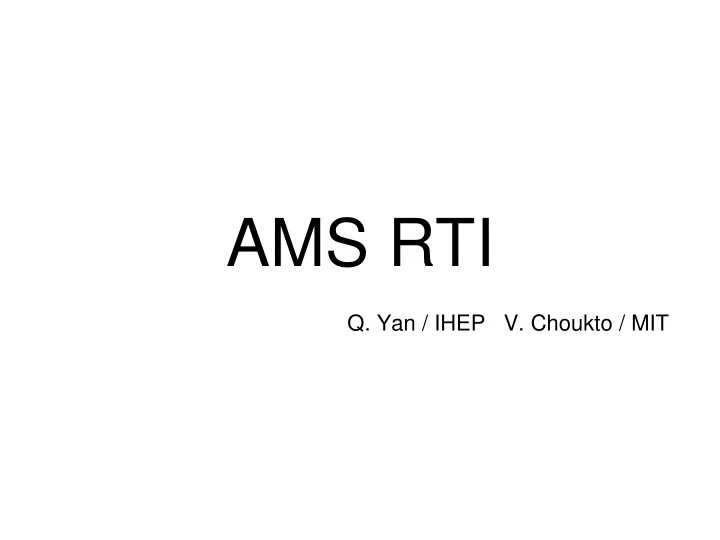

AMS RTI Q. Yan / IHEP V. Choukto / MIT
RTI Introduction 1: RTI record each second AMS global status, which include all pass4 data taking 2: RTI mainly used for exposure time calculation for flux and detector performance 3: The class include: run, evno, livetime, cutoff(MP-He-rigidity), AMS position(gtod+glat), events(miss events), particle- rec… 4: Flux calculation user can mask bad seconds and monitor detector performance 5: RTI is used to organize flux analysis from different group. Confirm reliable data-taking time
How To Use RTI(Events-Process) When process root file: (AMSEventR) 1: GetRTIStat() can use this function to get RTI status. normal return 0, If not: =>1: This second missed by RTI-file(report to qyan@cern.ch) =>2: This second has other problem bad return Solution: Please not use this second events for Flux- measurement 2: GetRTI(AMSSetupR::RTI &a) RTI information for this second User can choose not to use this second events, when events-number recorded by RTI abnormal
How To Use RTI(Time-Cal) When calculate exposure time: 1: static int GetRT(AMSSetupR::RTI &a, unsigned int xtime) static function to access RTI information for each second =>Time calculation can be done without any rootfiles. Just standalone Time-Loop Time second for data recorded, return 0, If not: =>1: This second no AMS-data =>2: This second missing(report to qyan@cern.ch) =>3: This second has other problem Bad return Solution: Please not to use this second for Expo-Time- Calculation
RTI Status 1: Second information include all pass4 has been record by RTI file in AMSDataDir: /afs/cern.ch/exp/ams/Offline/AMSDataDir/altec/RTI RTI_2011_140-24H.csv ~RTI_2013_008-24H.csv 2: After first run, a few run missing was observed, which reported by SH. Mainly due to castor problem, fixed by secondary double-check recently. 3: Almost all of data should has been recorded by RTI file, very few of them would be checked by third time afterwards. 4: Provide interface for access both in AMSSetupR and AMSEventR, which is flexible for data analysis.
Proposed Cuts • ntrig/nev>0.98 Before cuts • Eff>99.99% Rejected Accepted
Proposed Cuts • npart/ntrig>0.07/1600*ntrig && npart/ntrig<0.25 • Eff=99.2%
Proposed Cuts • Lf>0.5 • Eff=99.8%
Proposed Cuts • Zenith<40 • Eff=99.8%
Proposed Cuts • Nerr>=0 && nerr/nev<0.1 • Eff=99.97%
Proposed Cuts • Redundant Cut npart>0 && nev<1800 • Overal Cuts Efficiency=95.5%
Example: rigidity Cutoff • Lifetime Time X lf*nev/(nev+nerr) vs rigidity cutoff >1.1(Max RC40^o )
Simple Example Simple Example: 1: Event-Process: (Root-File) AMSEventR *ev=(AMSEventR *)ams.GetEvent(); AMSSetupR::RTI a; If(!pev->GetRTI(a))return false; If(a.npart<….||a.lf<…||a.nerr>…..)return false; 2: Time-Cal: Unsigned int bt=…//begin time Unsigned int et=…//end time double st=0; For(unsigned int t=bt; t<et;t++){ AMSSetupR::RTI a; If(!AMSEventR::GetRTI(a))continue; If(a.npart<….||a.lf<…||a.nerr>…..)continue; st+=a.lf*a.nev/(a.nev+a.nerr); }
Recommend
More recommend